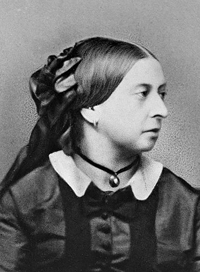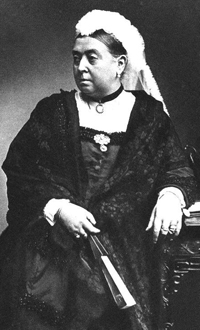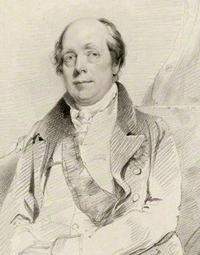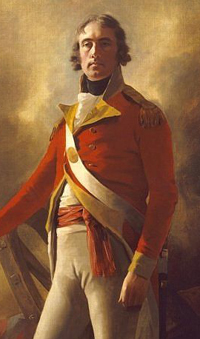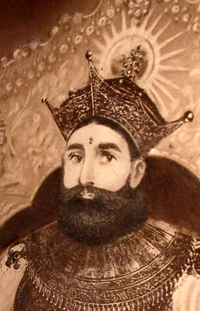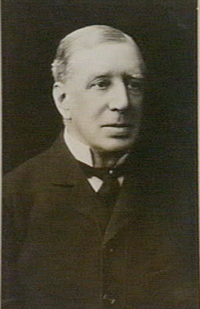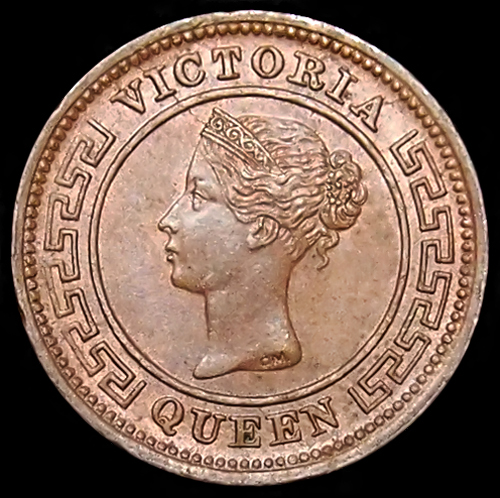
1/4 CENT COIN - SRI LANKA (CEYLON) - QUEEN VICTORIA
(KM 90) - Low Mintage
Date: A.D. 1890
Obverse: Portrait crowned head left inside key pattern border - VICTORIA QUEEN (small CM on bottom of bust Colombo Mint)
Reverse: Cocoa-palm tree and denomination inside border in Tamil and Sinhalese - Victoria- CEYLON QUARTER CENT 1890
Engraver: Leonard Charles Wyon
Queen Victoria around the time this portrait was created in 1860
Queen Victoria around the time this coin was minted in 1890
Frederick North, 5th Earl of Guilford: The first Governor of British Ceylon who oversaw the First Kandyan War
Scottish Major-general Hay MacDowall: 6th General Officer Commanding, Ceylon who commanded British forces in the First Kandyan War
Sri Vikrama Rajasinha: The last King of Kandy who resisted British rule, largely through guerrilla warfare, for 12 years until his defeat and exile to India in 1815
Sir Arthur Elibank Havelock: Became the 17th Governor of Ceylon the year this coin was minted.
Leonard Charles Wyon 1826-1891: Prolific master die-engraver and medalist who prepared many dies for coinage used all over the British Empire |
This Quarter cent was created late in the reign of Queen Victoria (but shows a decidedly young empress as was customary for provincial issues) by the British Empire who held the island of Sri Lanka (Ceylon) as the British Crown Colony of Ceylon from 1795 and 1948. Ceylon was a British crown colony for 146 years until gaining independence on February 4, 1948 when it became a Democratic Socialist Republic. The obverse is rather simple with the crowned bust of a young Queen Victoria inside a decorative key pattern border with the lettering VICTORIA at the top and QUEEN at the bottom. The letters CM appear on bottom of the bust and denote the Colombo Mint. The reverse depicts a cocoa-palm tree with CEYLON, the denomination spelled out QUARTER CENT and the date 1890 around the outer edge. The denomination is also on either side of the palm tree in Tamil and Sinhalese. Mintage for this year was 200,000 from a mintage of 776,000 total over four years 1870, 1890, 1898, 1901.
What would eventual become the Independent Democratic Socialist Republic of Sri Lanka was, in 1890, the British Crown Colony of Ceylon administered by a governor appointed by the monarch or parliament on the monarchs behalf. Initially the British did not hold the whole island. The Kingdom of Kandy resisted British rule as they had resisted the previous Dutch colonial government until it was transfered to the British after the Dutch Republic was conquered by Napoleonic France in 1795 and its leaders fled to London. Upon their arrival the British sought to incorporate the Kingdom of Kandy and unify the island under British rule but their attempts to secure a treaty with that kingdom were rejected. War between the British and the Kingdom of Kandy began in earnest in 1803 when forces consisting of British, Sinhalese and Malay soldiers under the command of Major-General Hay MacDowall and loyalist Kandyan resistance engaged in fierce fighting resulting in the British capture of the Kandy capital of Senkadagala which had already been deserted upon the arrival of British forces. The Kandyans put up fierce resistance resorting to fighting a guerrilla war in the countryside as they had done quite successfully before against the Portuguese and Dutch. They eventually retook Senkadagala killing all but one soldier (Corporal George Barnsley) of the British garrison there. After subsequent engagements British forces were forced to retreat and were again defeated near the Mahaveli river with only four survivors. The British were down but far from out. They did not become a vast empire by giving up after a few loses and they were adaptable, able to change tactics to adjust to wheresoever, and against whomever, they might be fighting at the time. The Kandyan army decided to mount a counter attack into British held territories but were decisively defeated and routed and their king Sri Vikrama Rajasinghe was forced to flee back into the mountains. Over the next seven years the British, under direction of the Governor Frederick North, maintained constant pressure on the Kandyan resistance. Kandy resistance fighters again defeated British forces who had moved into the mountainous territory where the native fighters were at an advantage. Again Kandy forces attacked the frontier town of Katuwana emboldened by their successes. What followed was a ten year cease of hostilities with the appointment of a new governor Thomas Maitland in 1805. Maitland pursued extensive legal and social reforms including reform of the civil service, the creation of a Ceylonese High Court based on existing caste law and he sought to attract European immigration to the island with large land grants. With the increasingly unpopular actions of the erratic and paranoid Kandy king Sri Vikrama Rajasinghe, who had begun to alienate Kandy nobles and commoners alike with arbitrary requisitions of land and treasure and a more tyrannical rule, many of the nobles began to see British rule as preferable. In 1815 Sri Vikrama Rajasinghe, now very unpopular, discovered several plots against him. The offender Ehelepola fled to British territory and the engaged king had the his entire family put to death which shocked the nobility who revolted against him forcing him to flee. Kandy forces were sent by the king to find Ehelepola in British territory where they killed a group of British traders at the kings command. British forces were then sent into Kandy territory and took the capital with little resistance. King Sri Vikrama Rajasinghe went into hiding but was eventually captured and sent into exile in India never to return to the island. The Kandyan Convention was agreed upon and signed by Kandy nobility and the British in March of 1815 which annexed the kingdom into British Ceylon. While it did not take long for the Kandy nobility to realize they did not want British rule and begin another guerrilla war in 1817, the war unsuccessful. The British essentially liquidated the old Kandy aristocracy in hopes of averting more conflict and while this did not completely end the the occasional uprising, none rose to a level that presented any serious threat to British domination again. This coin was minted under the administration of Sir Arthur Elibank Havelock, a career British colonial governor. Havelock had served as thee Governor of Trinidad and Natal before he was appointed Governor of Ceylon in 1890. His most notable actions taken as governor of Ceylon was to extend the railway system and abolish the 'paddy tax' which was a levy on rice cultivation. He served as Governor until October of 1895 after which he was appointed as Governor of Madras in India where he had spent much of his childhood. The coin was engraved by the prolific British engraver Leonard Charles Wyon who prepared many dies including the 'Bun Head penny" of 1860, gold and silver coinage for Victoria's Golden Jubilee, and like his father he created many more for use all throughout the empire. These were either from his own designs, other artists' models, or drawings supplied to him by the British and some of the British Oversea Governments. He produced coins for Australia, East Africa, Guiana, the West Indies, Honduras, India (and the indian states of Alwar, Bikanir, Dwas and Dgar), Canada, Hong Kong, Jamaica, Jersey, Malta, Mauritius, New Brunswick, Newfoundland, Nova Scotia, Prince Edward Island and the Straits Settlements. He also engraved many official military and portrait medals. Wyon was literally born into the profession as he was born in one of the houses in the Royal Mint in 1826. His father, William Wyon, was an engraver at the Mint who was appointed Chief Engraver in 1828. L.C. Wyon studied at the Merchant Taylor's School in London in Charterhouse Square on the north-eastern edge of the City where he was tutored in die engraving by his father. By the age of 16 he had already made several medals, some of which can be seen in the British Museum collection. He was appointed Second Engraver at the mint in 1844 and was appointed Modeler and Engraver in 1851 at the age of 24 as the position of Chief Engraver was retired when his father William passed away in 1851. Wyon was very prolific and, as he was trained by his father for just this type of artistry, he was completely dedicated to the art of the coin. Probably his most popular design was what is referred to as the Queen Victoria 'Bun Penny' on account of the queen's hair style. In 1860 he designed the new bronze coins for the United Kingdom (replacing his fathers young Victoria portrait). The queen herself took a personal interest in the design for the new minor coinage and gave several sittings to him for her portrait. This was the first bronze penny minted for the United Kingdom as they moved away from copper coinage for reasons of price and durability. In 1887 he engraved the unpopular Jubilee head of Queen Victoria (with the tiny crown) for the silver and gold coinages, however he was not responsible for the design itself, he was just the engraver. He also prepared the dies for most British military and naval medals from 1851 to 1891. Leonard Charles Wyon died at home in London, on August 20, 1891 and was buried at Paddington Old Cemetery. |

